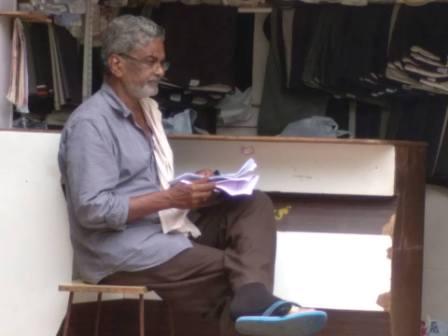Veewon Thokchom
The question of migrant population in the “Northeast” – Land of the rising sun, Land of festivals, Scotland of the East, Jewel of India – has always remained elusive in the popular discourse of the country, just as the question of occupation in Kashmir – a Paradise on Earth. These artfully contrived phrases used to describe certain regions of the country are rooted in the colonial production of knowledge about the “native” who always needed the civilizing hand of the West. Presently, however, the narrative of “national security,” “unemployment,” “underdevelopment,” “insurgency” etc. is prevalent in these regions. “Northeast,” more a capricious idea than a geographical location, is an imagination enforced from outside rather than emerging independently through a historical process of self-identification. This imagination, howsoever shrouded unsoundly, has no common standard except a shared marginalization from the mainland.
Today, Citizenship Amendment Bill 2016 (hereafter CAB), remains the most contentious bill in Manipur and the seven states of the “Northeast.” The bill seeks to amend the Citizenship Act 1955, which till date has been amended nine times in the Indian parliament. The numerous amendments are rendered possible because Article 11 of the Indian constitution allows the Parliament citizenship rights regulation by law at any time when deemed necessary. CAB was first proposed in the Lok Sabha on 19 July 2016 and was referred to the Joint Parliamentary Committee on 12 August of the same year. After the Committee submitted its report on 7 January this year, the bill was passed in the Lok Sabha on 8 January, introduced by the then Union Home Minister Rajnath Singh. On 13 February the bill lapsed as it was not introduced in the Rajya Sabha as a result of a wide mass protest from all over the entire “Northeast” region. Interestingly, the bill acted as a catalyst for the first united mass protest in these regions with the formation of pan body organizations like Northeast Forum for Indigenous People (NEFIP) and Northeast Students’ Organization (NESO).
The bill seeks to legalize unabated and unchecked influx of non-Indians from Afghanistan, Pakistan and Bangladesh belonging to six specific religious communities which the Indian government has termed “religiously persecuted minorities” – Parsi, Sikh, Hindu, Christian, Jain, Buddhist – providing 31 December 2014 as the cut-off year, leaving out the Muslim community. It also relaxes the minimum eleven years requirement under the Citizenship Act, 1955 for an individual belonging to these six categories to become a citizen to just six years. It should be remembered that the two notifications issued by the Ministry of Home Affairs in 2015 had mentioned exempting the provisions of Passport (Entry into India) Act, 1920 and The Foreigners Act, 1946 to non-Muslims individuals who entered India before 31 December 2014, therefore making such individuals eligible to apply for naturalization. This was not a surprising move from the central BJP regime which had promised to grant citizenship to Hindus facing persecution in the neighboring countries in the run-up to the 2014 General Election. The bill figures in 16th place in the Business List to be introduced in the winter session of the parliament which commenced on November 18. On account of the persistent commitment given by the BJP government and its majority presence in the parliament, there is a high possibility that the bill will be passed this winter session.
The historical genesis of the bill can be traced back to the bloody partition of India in 1947 when the Indian nationalist leadership made it clear during the Constituent Assembly Debates their concerns of the Hindus left out in East and West Pakistan. Correspondingly, Manipur, a political entity that precedes the Indian nation, made an independent trajectory towards a modern democratic nation when in 1948 elections were held based on universal adult franchise under the Manipur Constitution Act, 1947, considered second to Philippines in the whole South East Asiatic region.
In the “mainstream” political and even academic discourse, despite the elusiveness of the question of the migrant population in the “Northeast”, the discourse on National Register of Citizens (NRC) and to a lesser extent on Citizenship Amendment Bill (CAB), has occupied a dominant position. It is here that it becomes important to point out that the question of population transfer has remained an essential part of the nationalization and Hindunization of an appendage territory in the Indian state-building process. This is corroborated by the fact that Indian policy-makers proposed to settle 100,000 farmers from Punjab in the North-East Frontier Agency (NEFA) i.e. present-day Arunachal Pradesh just after the Indo-China war in 1962.
The discourse on the native, as opposed to settler population, has never been taken up in Indian academia despite it producing an immense number of upper-caste intellectuals in subaltern and postcolonial theories whose focus has included diaspora and Indian migrants in different countries. These theorists who emerged post-independence employ English, the language that enabled British rule over the subcontinent (Macaulay’s Minutes 1835), as a subversive means of challenging European discursive hegemony, despite claiming to have a rich thousand years old scripture, text, and philosophy. The purpose of mentioning this is to highlight the fallacy of the claim that they essentially represent the voice of the “voiceless” whose aspiration they purport to assert, the “unheard” masses hitherto “hidden from history” whose vocabulary is far from English language.
The overall political landscape of the “Northeast” vis-à-vis the “mainland” in present times is what necessitates a thorough engagement with the concept such as settler colonialism. Settler colonialism at its truest nature aims to eliminate an entire disposable native people because it is inherently eliminatory, and, erasure of indigeneity, native language, culture and traditions, ways of life, names of places, etc. of the native population is an essential component. In this project, the question of land becomes the most decisive factor, because land is life.
Settler colonial discourse when met with meticulous resistance, the natives are represented as xenophobic and chauvinist, or are discarded as wholly meaningless, or either brutally suppressed through the use of military and the “rule of law.” In this discourse, the native lands are always treated as remote land to be discovered and acquired over which modern industries and markets must be established. The powerful outsiders’ rights to buy always supersede the native’s rights not to sell. The ideological justification of the settlers for the dispossession of the natives is that they have an equally rightful claim to the territory accorded by a law book and that they know better how to use the land and resources of the newly conquered land. The natives’ claim to any right is obsolete and is a meaningless utterance in this discourse.
The projection of NRC as a xenophobic event rather than a bureaucratic process compelled by a mass movement by the indigenous people of Assam who are victims on the verge of losing their claims over their own land fails to historicize it when craftily employed with the impressive-sounding vocabulary of humanitarianism. Rather than exclusively and selectively posing the question, “What about those left out in the NRC?” it will also be worthwhile if the more crucial question, “What historical trajectory made NRC necessary in the first place?” is posed.
The Indian left-liberals which historically have remained a mute spectator in the gradual and complete colonization of Tripasa people by settlers from outside tend to look at the influx of population in the entire “Northeast” as proletariat, a classical perversion of Marxism. Ironically, in the “postcolonial” phase it was the Indian left which established itself socially and politically on the ashes of the dispossessed native Tripasa soil. The external so-called proletariat, in reality, serves as the main impetus for the Indian bourgeois project of fulfilling market’s imperative for expansion by curtailing the indigenous mode of production. The contradiction within Indian mainland societies too provides a precarious condition for immigration in the frontier societies at the expense of the native land, water, minerals, and livelihoods. On the back of this so-called “proletariat,” the Indian Marwari and Bania traders, who now control almost all the economic activities in the entire “Northeast” region, had already come riding, looking for indiscriminate profit.
The existence of the word “Mayang” in the vocabulary of the indigenous people of Manipur should be located in the “infra-politics” that emerged as a result of the everyday encounter with a settler population. This encounter made it indispensable for the native population to articulate a language that required identification of an “other,” the settler population. Despite its modern usage, the word has been in the cultural vocabulary for centuries. This identification and naming of an “other” is a global historical phenomenon in any oppressed condition. The Whites are Whites for the Blacks, Savarnas are Savarnas for the Dalit Bahujans, Dikkus just Dikkus for the Adivasis.
Now, it becomes all the more important to tell that one need not have to believe in the objective existence of race to be able to enquire the social, political and cultural relevance of the “idea of race.” The question of race needs a study to have a firm grasp on how race is socially and discursively constructed to maintain a structurally hegemonic relationship between people. Talking about race is not enforcing racial difference but it rather seeks to critique the oppressive relations that come along with relationships amongst races.
As has been frequently asserted by the White population in the West, and the Brown Hindu population in the Indian context, the notion of reverse-racism pops up every time there is a discourse on race in this country. It is a frequent scenario in “mainland” classrooms or office spaces. To bury the myth of “reverse-racism” it is imperative to understand that the word “Mayang” is a racial term. Racism is an institutionalized socio-political system of domination and Manipuris can never be racist to an “other” who occupies central position of power, just like the Blacks can never be racist to the Whites. This notion is a myth because it obfuscates the fundamental question of the location of power between the sets of the population involved in this unequal relationship. There is nothing as reverse-racism, just like there is nothing such as reverse-colonialism or reverse-casteism. Anticolonial movement is not reverse-colonialism and anti-caste movement is not reverse-casteism. The word “Mayang” has assumed a political language of resistance that challenges systematic domination, and its usage takes place at the level of a conscious political act.
The racial prejudice backed with power, that is racism, is not new in this nation; it is as old as the nation made explicit by Sardar Patel’s statement, the then Home Minister, in 1950 that “the people inhabiting these portions (“Northeast”) have no established loyalty or devotion to India …. are not free from pre-Mongoloid prejudices.” The same racial prejudice was not lacking in the case of the oldest freedom struggle of this nation when in 1951 the President of the Naga National Council (NNC), A.Z. Phizo invoked racial difference in the Naga’s claim for independence from India and stated, “It is an undeniable fact that Nagas are not Indians. We distinctly and unmistakably belong to the great Mongoloid family. The most important thing to consider is not merely one of politics but it is rather a problem of biology and psychology.” However, the difference between the former and the latter is the unsurmountable chasm that lies between racism and race thinking.
Representation of the “Northeast” in Bollywood popular culture in films like Yeh Gulistan Hamara (1972), Dil Se (1998), Tango Charlie (2005), Mary Kom (2014) is not free from bias and is a part of a concerted indulgence with a mode of production of knowledge. Here, the intended portrayal is the feminization or destabilization of an entire racial “other” which invites the mastery of Indian masculinity and military hand to restore “law and order.” The movies are made solely for the market in the larger Indian mainland audience. It remains imperative to call into question the assumptions of the innocence of these stories woven in grand narratives because these have intimate roots in the general racist outlooks that revert to colonial imagination and attitude. If the popular imagination of America in the Indian minds is received through Hollywood movies, via which they also receive the imageries of Islamic “Middle East,” most people in India know about the “Northeast” through the kind of images they receive in the Indian Bollywood movies, television, and the media – a primary repository of the imageries of “Northeast.”
Though the real aspiration, historical and political narratives of the “Northeast” are given the status of a footnote in the Indian political and intellectual domains, mass media have always maintained a relentless dominant hegemonic role in shaping the idea of “Northeast” in the mainland. However, as long as there are greater degrees of marginalization accompanying these preposterous representations, it is necessary that our assertion should be stronger and the collective future not bartered.
CAB, or any other law such as Armed Forces Special Powers Act, 1958 (AFSPA), when contextualized in the Indian nation-building process, and understood in all its messiness, essentially advocates the speedy assimilation of the indigenous population of the “Northeast” through the employment of the project of settler colonialism. The essence of the bill lay in its potential exterminating quality of a racially different population, and epitomizes an indiscriminate lust for land, resources, and market, already laid the ground fertile by a permanent “state of exception.” The uncompromising opposition of the people to this bill is not for its “anti-secular” nature but for its monstrous power to annihilate the entire Mongoloid racial population in this country.
The Manipur BJP government, an extension of a Hindutva hand from Delhi, on 14 January 2019 celebrated the lapse of the bill as a victory-claim of the state government’s effort to stop the bill. At times they have claimed that a clause will be inserted to safeguard the interests of Manipur, and at other times stated that the bill in itself will not affect Manipur at all. While the stand of the BJP Manipur government is evidently ambiguous and attracts mockery and contempt of the electoral political leaders, the people have made their position clear and direct. As the government starts to arrest leaders and activists, more protests, and conversely, curfews and internet shut down is to follow in the coming days.
As has been asked by intellectuals from Manipur, on what basis and rationale does Manipur share the historical and political burden of India’s partition in 1947, two years before Manipur was forcefully taken over and annexed by India in 1949 and became a territorial part albeit there was an emotional and ideological lack, the deepest wound inflicted in Manipur’s history which laid the foundation for present-day uncertainties and uproars?
~~~
Veewon Thokchom is from Manipur, he is the fourth child of his parents, has done his schooling in Manipur, Uttarakhand, Kerala, and Karnataka. He graduated in 2016 graduated from Kirori Mal College (Delhi University) and did his masters in History at Ambedkar University, Delhi.









